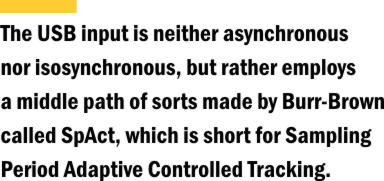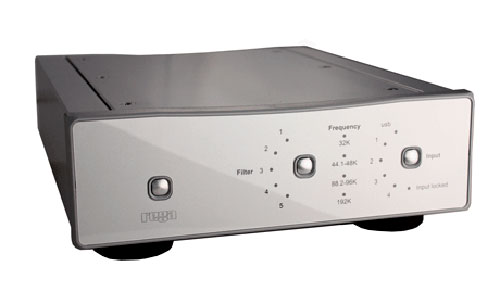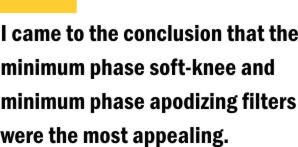Rega • DAC Digital-to-Analog Converter
oy Gandy, Rega’s founder and driving force -- not to mention the source of the company's name -- is not your average hi-fi luminary, the green bow ties he has been seen sporting and the table tennis bats (known elsewhere as "ping pong paddles") that the company once made notwithstanding. He doesn't spend a lot of his time at the Rega offices. Instead he works from home and concentrates on the big picture, an approach that seems to be working rather well. June 2011 was Rega’s best month ever in terms of order value, thanks to a resurgence in appreciation of turntables, including an expanding product range that added a replacement for the P324 turntable called the RP3, the latest generation of the Planar 3, which literally launched the company.
The Rega DAC is housed in a new style of chassis for the brand, but one that is now also used for the new Brio-R integrated amplifier. This half-width design makes the cast-aluminum casework found elsewhere in the range look quite agricultural. The DAC has an ABS plastic front panel with a high-gloss finish that contrasts with the matte black of the aluminum-and-steel chassis. Three buttons control power, input selection and filter choice, the latter coming in no fewer than five flavors, a baffling array by anyone’s standards. You switch among them manually, as there’s no remote control to be had. To add an element of confusion, the filter settings vary according to the sample rate of the material being converted. Terry Bateman explained: "There are three separate sets of filter modes within the DAC, which are selected via the firmware, depending on the incoming sample rate. These consist of low-mode 32/44.1/48kHz, medium-mode 88.2/96kHz and finally high-mode 176.4/192kHz." For rates up to 48kHz, the following filters are available: linear phase half-band, minimum phase soft-knee, minimum phase half-band, linear phase apodizing and minimum phase apodizing. At rates from 88.2 to 192kHz, the settings have rather different effects. This is because with wider-bandwidth signals you can use smoother filters, so there is no need for the sharp 20kHz filter required with CD systems, where the frequency range can only extend to 22.05kHz. The DAC has plenty of inputs, including the usual S/PDIF varieties
alongside a USB B socket for direct connection to a computer, preferably a fairly local
Mac or PC, because USB doesn’t work so well over long distances. The USB input is
neither asynchronous nor isosynchronous, but rather employs a middle path of sorts made by
Burr-Brown called SpAct, which is short for Sampling Period Adaptive Controlled Tracking.
This reclocks the incoming signal, but it is a simpler and less expensive approach than
asynchronous USB interfaces. Rega has also gone to considerable lengths to isolate the
interface electrically. Perhaps the biggest issue with computers as audio sources is the
amount of noise their switching power supplies dump onto the ground plane, noise that
comes down the USB cable with the signal. Rega isn’t the first company to address
this problem, but they are the first to address it in an entry-level converter. The DAC has plenty of inputs, including the usual S/PDIF varieties
alongside a USB B socket for direct connection to a computer, preferably a fairly local
Mac or PC, because USB doesn’t work so well over long distances. The USB input is
neither asynchronous nor isosynchronous, but rather employs a middle path of sorts made by
Burr-Brown called SpAct, which is short for Sampling Period Adaptive Controlled Tracking.
This reclocks the incoming signal, but it is a simpler and less expensive approach than
asynchronous USB interfaces. Rega has also gone to considerable lengths to isolate the
interface electrically. Perhaps the biggest issue with computers as audio sources is the
amount of noise their switching power supplies dump onto the ground plane, noise that
comes down the USB cable with the signal. Rega isn’t the first company to address
this problem, but they are the first to address it in an entry-level converter.
Usefully, the DAC also has two RCA coax and two TosLink optical inputs, which should be sufficient for most audio systems. Having said that, it’s well worth using a decent DAC with video sources if you don’t need surround sound. I realize this probably narrows the field in the US, but whenever I watch concerts on Blu-ray Disc, I prefer the stereo feed. This may well be a symptom of audiophilia nervosa! The Rega DAC has an unusual choice of power socket: not an IEC type of the variety that is almost ubiquitous but a cloverleaf design that I’ve not previously encountered. This was chosen because it saves space inside the box, where component density meant a three-core IEC socket would be too big. As with most Rega products, analog output is on single-ended jacks only. The DAC’s S/PDIF inputs can accept signals up to 24 bits and 192kHz and cover all the standard points in between. However, its USB input is only equipped to work with rates up to 16 bits and 48kHz, so essentially CD data rates, which will be fine for most situations but will undermine your high-def downloads from HDtracks and the like. Rega points out that in order to "ascertain [that] the playback chain is capable of true 96 and 192k operation" the frequency response and THD of a high-sample-rate music server be tested with high-frequency tones. This is apparently a disclaimer included, because Terry Bateman had difficulties in getting reliable high-sample-rate signals out of PCs running anything before Windows 7. There are sample-rate indicator lights on the DAC’s front panel, but these only tell what rate the DAC is operating at and not necessarily the actual incoming rate, especially above 96kHz, where things start to become less predictable. have to admit that Rega's Valve Isis CD player ($9995), which I reviewed a year ago, raised my expectations perhaps too high for the DAC to live up to. I had optimistically hoped that despite the massive difference in price that the DAC would bring the addictive sound of the Valve Isis back to my listening room. This was naturally not the case, but after a while and a bit of experimentation with the filter settings the DAC started to make a very positive impression. Its ability to engage me with the music is what set it apart from the crowd, and the same was true of the Valve Isis, so there is a fundamental similarity. The DAC's presentation has a strong sense of life and vitality, beating a Stello DA100 Signature converter rather easily in this respect and clearly improving on it in timing terms too. This comparison also revealed that the DAC is good at portraying image depth and impressive with instrumental tone. It’s certainly capable of revealing the richness of a good recording and delivered a genuinely widescreen experience with one of my favorite tracks from Kip Hanrahan's Conjure [American Clavé/HDtracks 42135], "Foolology." An Arcam rDac also passed through my system at the same time as the Rega DAC, and this presented a stiffer challenge by delivering more weight, greater dynamics and increased transparency, with the result being harder-hitting beats from a number of tracks. Going back to the Rega proved that there was more to its musical experience, by delivering a strong sense of flow in a relatively relaxed fashion. It was neither as detailed nor as powerful-sounding as the rDAC, but it made the music more interesting and enjoyable, which is ultimately what we should be seeking in an audio component.Dave Brubeck’s signature "Take Five" (from Time Out [Columbia/Legacy CK 65122]) allowed the DAC to revel in the quality of the drum work, with all of its reverb and dynamics. More significant, however, was the way the interplay between the musicians was brought to the fore. The sound was one thing, but it wouldn’t have worked if the people making it weren’t interacting so tightly -- totally as one with each other and the beat. This is what the Rega let me hear; this is what made it so compelling.
Moving to the USB signal from a MacBook made it necessary to reassess these settings again. The first track I listened to was "Walk on the Wild Side," from Lou Reed's well-known Transformer album [BMG 74321 601812], which sounded open and natural via the m inimum phase apodizing filter, if a little soft. Switching to minimum phase soft-knee brought a bit of extra definition and sharpened up the timing to good effect without undermining the texture of Herbie Flowers’ superb double-bass playing. The Talk Talk track "Happiness is Easy" from The Colour of Spring [EMI CDP 7462282] was conversely a bit too hard-edged on this setting and worked better via minimum phase apodizing, which allowed the music to take precedence over the slightly forward '80s mix featuring the same bass player.Further listening revealed that the Rega DAC was remarkably capable and entertaining when used with computer files. It was not super clean nor hugely spacious, but it was extremely musical and detailed for the price. Fleetwood Mac’s "Never Going Back," (from Rumours [Warner Bros C88 1-1]), which is 90% Lindsay Buckingham and his virtuoso picking skills, sounded crisp and zingy, the fresh strings contrasting dramatically with the luxurious backing vocals of Stevie Nicks and Christine McVie. Equally enjoyable -- albeit for different reasons -- was Wyclef Jean’s "Thug Angels" from his The Ecleftic: 2 Sides II a Book [Columbia 497979]. This has some extremely lithe bass lines that twist and turn but keep propelling the beat. The Rega DAC revealed the deftness of the playing, along with the texture and tone of bass drum and guitar without detracting from the vocals that sit at the heart of the mix. I really enjoyed the way that the DAC let me hear precisely what was going on without getting in the way of the musical flow. The final track I elected to push down the USB cable was ZZ Top’s "Enjoy and Get it On" from Tejas [Warner Bros. 2-3272], as fine an example of funk rock as you’ll find. Unsurprisingly, the DAC delivered all of the cut's tight groove and laid the glorious tone of Billy Gibbons’ guitar over the top. It wasn't quite up with a decent turntable, but that would cost significantly more, and the vinyl isn't that easy to come by. It’s about time the reissue labels got around to mainstream classics like this. his remarkably capable and enjoyable DAC is not a Valve Isis on the cheap -- that would be asking for too much -- but it delivered some of that machine’s ability to make me want to keep on listening and at a very competitive price. It can do this with S/PDIF and USB sources with equal ease and will outgun its obvious competitors in most of the important respects. It even outperformed some considerably more expensive DACs in the timing realm, and that is the most important quality where musical engagement is concerned -- and the one that Rega clearly prizes above all others.
|


 The existence of those five
filter settings meant that each had to be tried. In fact, this was the first thing I did
after the initial running-in period had passed.
The existence of those five
filter settings meant that each had to be tried. In fact, this was the first thing I did
after the initial running-in period had passed.